Class 9 - Mathematics
- Exercise

Top Block 1
Exercise 9.3
Question : 1 : In the given figure, E is any point on median AD of a ∆ABC. Show that: ar (ABE) = ar (ACE)

Answer :
AD is the median of ∆ABC. Therefore, it will divide ∆ABC into two triangles of equal areas.
So, Area (∆ABD) = Area (∆ACD) … (1)
ED is the median of ∆EBC.
So, Area (∆EBD) = Area (∆ECD) … (2)
On subtracting equation (2) from equation (1), we obtain
Area (∆ABD) − Area (EBD) = Area (∆ACD) − Area (∆ECD)
Area (∆ABE) = Area (∆ACE)
Question : 2: In a triangle ABC, E is the mid-point of median AD. Show that ar(BED) = ar(ABC)/4 .
Answer :
Given ABC is a triangle in which E is the mid-point of the median.
Since median of a triangle divides a triangle into two equal triangles of equal area.
So area of Δ ABD = 1/2 * area of Δ ABC
Again BE is the median of the triangle ABD.
So area of Δ BDE =1/2 * area of Δ ABD
= 1/2 *1/2 * area of Δ ABC
= 1/4 * area of Δ ABC
So, area of Δ BDE = 1/4 * area of Δ ABC
Question : 3: Show that the diagonals of a parallelogram divide it into four triangles of equal area.
Answer :
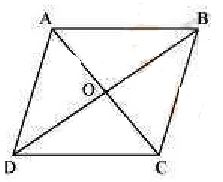
Mddle block 1
We know that diagonals of parallelogram bisect each other.
Therefore, O is the mid-point of AC and BD.
BO is the median in ∆ABC.
Therefore, it will divide it into two triangles of equal areas.
So, Area (∆AOB) = Area (∆BOC) … (1)
In ∆BCD, CO is the median.
So, Area(∆BOC) = Area(∆COD) … (2)
Similarly, Area(∆COD) = Area(∆AOD) … (3)
From equations (1), (2), and (3), we obtain
Area (∆AOB) = Area (∆BOC) = Area (∆COD) = Area (∆AOD)
Therefore, it is evident that the diagonals of a parallelogram divide it into four triangles of
equal area.
Question : 4: In Fig. 9.24, ABC and ABD are two triangles on the same base AB. If line- segment CD is bisected
by AB at O, show that ar(ABC) = ar(ABD).
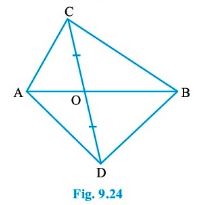
Answer :
Consider ∆ACD.
Line-segment CD is bisected by AB at O. Therefore, AO is the median of ∆ACD.
So, Area (∆ACO) = Area (∆ADO) … (1)
Considering ∆BCD, BO is the median.
So, Area (∆BCO) = Area (∆BDO) … (2)
Adding equations (1) and (2), we obtain
Area (∆ACO) + Area (∆BCO) = Area (∆ADO) + Area (∆BDO)
⇒ Area (∆ABC) = Area (∆ABD)
Question : 5: D, E and F are respectively the mid-points of the sides BC, CA and AB of a ∆ ABC.
Show that:
(i) BDEF is a parallelogram.
(ii) ar(DEF) = ar(ABC)/4
(iii) ar(BDEF) = ar(ABC)/2
Answer :

Given: D, E and F are the mid-points of the sides BC, CA and AB of ΔABC.
(i) In ΔABC,
F is the mid-point of side AB and E is the mid-point of side AC.
So, EF || BC
In a triangle, the line segment joining the mid-points of any two sides is parallel to the third
side.
So, EF || BD ………..1
Similarly, ED || BF …….2
From equation 1 and 2, we get
BDEF is a parallelogram [a quadrilateral is a parallelogram if opposite sides are parallel]
(ii) As in (i), we can prove that
AFDE and FDCE are parallelograms.
FD is a diagonal of the parallelogram BDEF.
So, area(ΔFBD) = area(ΔDEF) ……………3
Similarly, area(ΔDEF) = area(ΔEAE) ……………4
and area(ΔDEF) = area(ΔDCE) ……………5
From equation 3, 4 and 5, we get
area(ΔFBD) = area(ΔDEF) = area(ΔFAE) = area(ΔDCE) …………6
So, ΔABC is divided into four non-overlapping triangles ΔFBD, ΔDEF, ΔFAE and ΔDCE.
Hence, area(ΔABC) = area(ΔFBD) + area(ΔDEF) + area(ΔFAE) + area(ΔDCE) + area(ΔDEF)
⇒ area(ΔABC) = 4 * area(ΔDEF) [From equation 6]
⇒ area(ΔDEF) = area(ΔABC)/4 ……..7
(iii) area(BDEF) = area(ΔFBD) + area(ΔDEF) [From equation 3]
= area(ΔDEF) + area(ΔDEF)
= 2 * area(ΔDEF)
= 2 * area(ΔABC)/4
= area(ΔABC)/2
Question : 6: In Fig. 9.25, diagonals AC and BD of quadrilateral ABCD intersect at O such that OB = OD.
If AB = CD, then show that:
(i) ar(DOC) = ar(AOB) (ii) ar(DCB) = ar(ACB)
(iii) DA || CB or ABCD is a parallelogram.
[Hint: From D and B, draw perpendiculars to AC.]
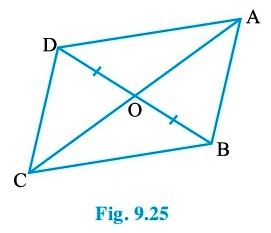
Answer :
Let us draw DN ⊥ AC and BM ⊥ AC.
(i) In ∆DON and ∆BOM,
∠DNO = ∠BMO (By construction)
∠DON = ∠BOM (Vertically opposite angles)
OD = OB (Given)
By AAS congruence rule,
∆DON ≅ ∆BOM
DN = BM … (1)
We know that congruent triangles have equal areas.
Area (∆DON) = Area (∆BOM) … (2)
In ∆DNC and ∆BMA,
∠DNC = ∠BMA (By construction)
CD = AB (Given)
DN = BM [Using equation (1)]
So, ∆DNC ≅∆BMA (RHS congruence rule)
Area (∆DNC) = Area (∆BMA) … (3)
On adding equations (2) and (3), we obtain
Area (∆DON) + Area (∆DNC) = Area (∆BOM) + Area (∆BMA)
Therefore, Area (∆DOC) = Area (∆AOB)
(ii) We obtained,
Area (∆DOC) = Area (∆AOB)
Area (∆DOC) + Area (∆OCB) = Area (∆AOB) + Area (∆OCB) [Adding Area (∆OCB) to both sides]
Area (∆DCB) = Area (∆ACB)
(iii) We obtained,
Area (∆DCB) = Area (∆ACB)
If two triangles have the same base and equal areas, then these will lie between the same
parallels.
So, DA || CB … (4)
In quadrilateral ABCD, one pair of opposite sides is equal (AB = CD) and the other pair of
opposite sides is parallel (DA || CB).
Therefore, ABCD is a parallelogram.
Question : 7: D and E are points on sides AB and AC respectively of ∆ ABC such that ar (DBC) = ar (EBC).
Prove that DE || BC.
Answer :

Since ∆BCE and ∆BCD are lying on a common base BC and also have equal areas,
∆BCE and ∆BCD will lie between the same parallel lines.
So, DE || BC
Question : 8: XY is a line parallel to side BC of a triangle ABC. If BE || AC and CF || AB meet XY at E and F respectively, show that ar(ABE) = ar(ACF)
Answer :
It is given that XY || BC and EY || BC BE || AC and BE || CY
Therefore, EBCY is a parallelogram.

It is given that
XY || BC and XF || BC
FC || AB and FC || XB
Therefore, BCFX is a parallelogram.
Parallelograms EBCY and BCFX are on the same base BC and between the same parallels BC
and EF.
So, Area (EBCY) = Area (BCFX) … (1)
Consider parallelogram EBCY and ∆AEB
These lie on the same base BE and are between the same parallels BE and AC.
So, Area (∆ABE) = Area (EBCY) … (2)
Also, parallelogram BCFX and ∆ACF are on the same base CF and between the same parallels
CF and AB.
So, Area (∆ACF) = Area (BCFX) … (3)
From equations (1), (2), and (3), we obtain
Area (∆ABE) = Area (∆ACF)
Question : 9: The side AB of a parallelogram ABCD is produced to any point P. A line through A and parallel to CP
meets CB produced at Q and then parallelogram PBQR is completed (see Fig. 9.26).
Show that ar (ABCD) = ar (PBQR).
[Hint: Join AC and PQ. Now compare ar(ACQ) and ar(APQ).]

Answer :
Let us join AC and PQ.
∆ACQ and ∆AQP are on the same base AQ and between the same parallels AQ and CP.
So, Area (∆ACQ) = Area (∆APQ)
⇒ Area (∆ACQ) − Area (∆ABQ) = Area (∆APQ) − Area (∆ABQ)
⇒ Area (∆ABC) = Area (∆QBP) … (1)
Since AC and PQ are diagonals of parallelograms ABCD and PBQR respectively,
Area (∆ABC) = Area (ABCD)/2 … (2)
Area (∆QBP) = Area (PBQR) … (3)
From equation 1, 2 and 3, we get
Area (ABCD)/2 = Area (PBQR)/2
⇒ Area (ABCD) = Area (PBQR)
Question : 10: Diagonals AC and BD of a trapezium ABCD with AB || DC intersect each other at O. Prove that ar(AOD) = ar(BOC).
Answer :
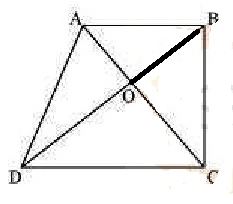
It can be observed that ∆DAC and ∆DBC lie on the same base DC and between the same
parallels AB and CD.
Area(∆DAC) = Area(∆DBC)
Area(∆DAC) – Area(∆DOC) = Area(∆DBC) – Area(∆DOC)
Area(∆AOD) = Area(∆BOC)
Question : 11: In Fig. 9.27, ABCDE is a pentagon. A line through B parallel to AC meets DC produced at F. Show that
(i) ar (ACB) = ar (ACF)
(ii) ar (AEDF) = ar (ABCDE)

Answer :
(i) ∆ACB and ∆ACF lie on the same base AC and are between the same parallels AC and BF.
So, Area (∆ACB) = Area (∆ACF)
(ii) It can be observed that
Area (∆ACB) = Area (∆ACF)
Area (∆ACB) + Area (ACDE) = Area (ACF) + Area (ACDE)
Area (ABCDE) = Area (AEDF)
Question : 12: A villager Itwaari has a plot of land of the shape of a quadrilateral. The Gram Panchayat of the village decided to take over some portion of his plot from one of the corners to construct a Health Centre. Itwaari agrees to the above proposal with the condition that he should be given equal amount of land in lieu of his land adjoining his plot so as to form a triangular plot. Explain how this proposal will be implemented.
Answer :
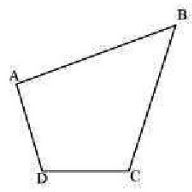
Let quadrilateral ABCD be the original shape of the field.
The proposal may be implemented as follows.
Join diagonal BD and draw a line parallel to BD through point A. Let it meet the extended side
CD of ABCD at point E. Join BE and AD. Let them intersect each other at O. Then, portion ∆AOB
can be cut from the original field so that the new shape of the field will be ∆BCE. (See figure)
We have to prove that the area of ∆AOB (portion that was cut so as to construct Health
Centre) is equal to the area of ∆DEO (portion added to the field so as to make the area of the
new field so formed equal to the area of the original field)
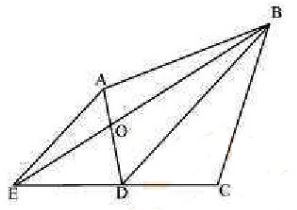
It can be observed that ∆DEB and ∆DAB lie on the same base BD and are between the same
parallels BD and AE.
So, Area (∆DEB) = Area (∆DAB)
⇒ Area (∆DEB) − Area (∆DOB) = Area (∆DAB) − Area (∆DOB)
⇒ Area (∆DEO) = Area (∆AOB)
Question : 13: ABCD is a trapezium with AB || DC. A line parallel to AC intersects AB at X and BC at Y.
Prove that ar(ADX) = ar(ACY). [Hint: Join CX.]
Answer :
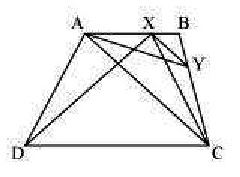
It can be observed that ∆ADX and ∆ACX lie on the same base AX and are between the same
parallels AB and DC.
So, Area (∆ADX) = Area (∆ACX) ………..1
∆ACY and ∆ACX lie on the same base AC and are between the same parallels AC and XY.
So, Area (∆ACY) = Area (∆ACX) ………..2
From equation 1 and 2, we get
So, Area (∆ADX) = Area (∆ACY)
Question : 14: In Fig.9.28, AP || BQ || CR. Prove that ar(AQC) = ar(PBR).

Answer :
Since ∆ABQ and ∆PBQ lie on the same BQ and are between the same parallels AP and BQ.
So, Area(∆ABQ) = Area(∆PBQ) ………1
Again ∆BCQ and ∆BRQ lie on the same BQ and are between the same parallels BQ and CR.
So, Area(∆BCQ) = Area(∆BRQ) ………2
On adding equation 1 and 2, we get
Area(∆ABQ) + Area(∆BCQ) = Area(∆PBQ) + Area(∆BRQ)
⇒ Area(∆AQC) = Area(∆PBR)
Question : 15: Diagonals AC and BD of a quadrilateral ABCD intersect at O in such a way that ar (AOD) = ar (BOC). Prove that ABCD is a trapezium.
Answer :

It is given that
Area (∆AOD) = Area (∆BOC)
Area (∆AOD) + Area (∆AOB) = Area (∆BOC) + Area (∆AOB)
Area (∆ADB) = Area (∆ACB)
We know that triangles on the same base having areas equal to each other lie between the
same parallels.
Therefore, these triangles, ∆ADB and ∆ACB, are lying between the same parallels.
i.e., AB || CD
Therefore, ABCD is a trapezium.
Question : 16: In Fig.9.29, ar (DRC) = ar (DPC) and ar (BDP) = ar (ARC). Show that both the quadrilaterals ABCD and DCPR are trapeziums.

Answer :
It is given that
Area (∆DRC) = Area (∆DPC)
As ∆DRC and ∆DPC lie on the same base DC and have equal areas, therefore, they
must lie between the same parallel lines.
So, DC || RP
Therefore, DCPR is a trapezium.
It is also given that
Area (∆BDP) = Area (∆ARC)
⇒ Area (BDP) − Area (∆DPC) = Area (∆ARC) − Area (∆DRC)
⇒ Area (∆BDC) = Area (∆ADC)
Since ∆BDC and ∆ADC are on the same base CD and have equal areas, they must lie between
the same parallel lines.
So, AB || CD
Therefore, ABCD is a trapezium.

